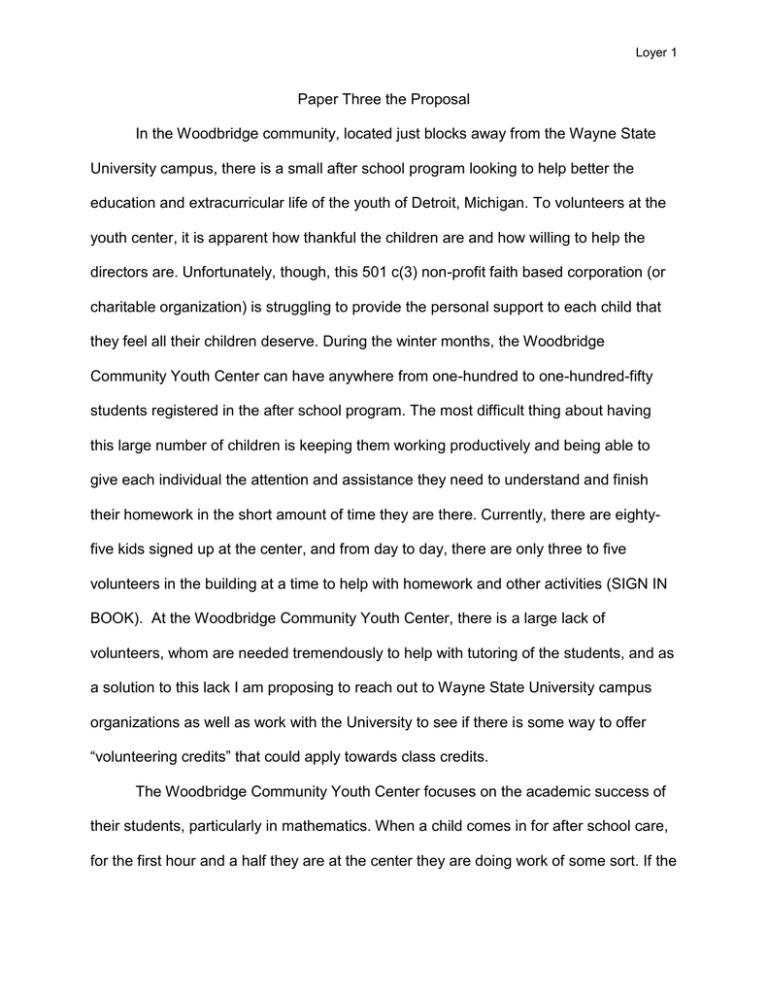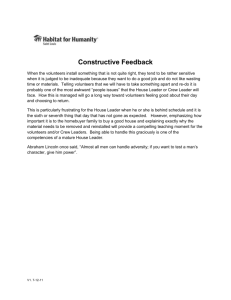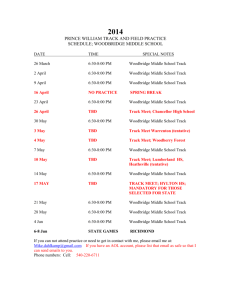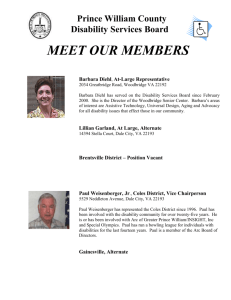Example proposal 3
advertisement

Loyer 1 Paper Three the Proposal In the Woodbridge community, located just blocks away from the Wayne State University campus, there is a small after school program looking to help better the education and extracurricular life of the youth of Detroit, Michigan. To volunteers at the youth center, it is apparent how thankful the children are and how willing to help the directors are. Unfortunately, though, this 501 c(3) non-profit faith based corporation (or charitable organization) is struggling to provide the personal support to each child that they feel all their children deserve. During the winter months, the Woodbridge Community Youth Center can have anywhere from one-hundred to one-hundred-fifty students registered in the after school program. The most difficult thing about having this large number of children is keeping them working productively and being able to give each individual the attention and assistance they need to understand and finish their homework in the short amount of time they are there. Currently, there are eightyfive kids signed up at the center, and from day to day, there are only three to five volunteers in the building at a time to help with homework and other activities (SIGN IN BOOK). At the Woodbridge Community Youth Center, there is a large lack of volunteers, whom are needed tremendously to help with tutoring of the students, and as a solution to this lack I am proposing to reach out to Wayne State University campus organizations as well as work with the University to see if there is some way to offer “volunteering credits” that could apply towards class credits. The Woodbridge Community Youth Center focuses on the academic success of their students, particularly in mathematics. When a child comes in for after school care, for the first hour and a half they are at the center they are doing work of some sort. If the Loyer 2 students say they don’t have homework from the school day, they are given a worksheet that helps them practice their math skills. Due to the small amount of dedicated volunteers, the necessary one on one experience needed to provide the students with the proper atmosphere to excel cannot be achieved, therefore the ratio of students to teachers will continue to grow. Although each tutor helps all the children as much as they are able, the number of children far outweigh the volunteers; therefore forcing some student to wait for help or rely on other students to help them with their homework. The learning styles of each child at the center are different as well; some children find it difficult to concentrate on their work if there are others talking around them, where others find it impossible even to sit still because of their friends being in the same room. By introducing more tutors to the center on a daily basis, each student would be able to have the individual attention needed to improve academically and keep them focused on their work. “Afterschool Alliance,” an organization dedicated to raising awareness to the importance of after school programs, publishes monthly newsletters on common issues in the after school family. According to one of the studies, “Forming healthy relationships with program staff can lead to a positive emotional climate for students, allowing them to feel comfortable learning and exploring. Factors that serve as a catalyst for establishing these bonds are small staff-child ratio and a well-prepared and compensated staff” (Grant 2). By shrinking the ratio of students to tutors there will no longer be the overwhelmed feeling of needing to help too many kids, and at the same time, the children will have that needed support when finishing homework or working on a difficult math problem. Loyer 3 Some specific Wayne State University organizations to reach out to for extra volunteers are the Community of Scholars and the Honors College. The Community of Scholars and the Honors College both require service learning hours in order to graduate with those specific titles. Reaching out to these specific organizations will benefit both the Woodbridge Community Youth Center and Wayne State University. According to research done by Olatokunbo S. Fashola from Johns Hopkins University on the effectiveness of after-school programs, “In addition to providing supervision, after-school and extended school-day programs are now being seen as a means of improving academic achievement, providing opportunities for academic enrichment and providing social, cultural, and recreational activities…” (9). It could be said too, that the same experiences are received by the volunteering students as well. When the Honors and Scholars students from the University participate in the supervision part of the afterschool program, both the children at the youth center and the college students are gaining the academic enrichment as well as the social, cultural and recreational activities described by Fashola. The academic enrichment comes from the interaction with the youth and the distinguished individuals from the University. When an eightyear-old child can look at someone more than twice their age and confidently say that they want to go to college to read Shakespeare and become a writer, the person working with that child cannot help but to feel proud that the child is gaining something from their experience together. The social, cultural, and recreational activities can include anything from the conversation between the children at the Youth center and the University students, to games played in the gym between the two. The Woodbridge Community Youth Center offers various activities for the participating youth, from art Loyer 4 and archery, to basketball and dance. The volunteers who stay after tutoring hours also help a lot with keeping these different activities running smoothly. Interacting in these different extracurricular activities are... When depending on volunteers though, there are bound to be some difficulties when trying to get more tutors for the Woodbridge Community Youth Center. College students serving as volunteers risk acting as unwanted influences on children. The college life is notoriously hectic, with classes, social obligations and homework, and when a group of college aged students are together, conversation can wander off. This could be problematic when a student overhears and repeats to a teacher or a parent. Along with the hectic schedule of college life, the University school schedule is not the same as that of the public school system that the youth center parallels. When the University has holiday break and spring break, public schools, as well as the Woodbridge center, are still in session, and visa versa. The Woodbridge students develop a trusting relationship with their University volunteers, and during these crossovers of schedules, it allows for the WCYC youth to fall behind in the progress previously established between the two groups. This break in time spent together, because of schedule conflict, then leads to a “catch-up” period once the two are reunited. Another obstacle when depending on college organizations is the previous obligations to other charities. At the start of each semester, students commit to different organizations to complete their service learning hours with. A student who has previously committed to another organization would not be able to switch to the Woodbridge Community Youth Center half way thorough a semester. Yet, at the same time, reaching out to organizations like the Honors College and the Community of Loyer 5 Scholars can be beneficial. These two communities post a list of possible volunteer opportunities and the students are able to pick which one they wish to participate in. Also, if the Woodbridge center were to make an agreement with a students for the following academic year, they can secure tutors annually. There are many different tactics to consider when asking for volunteers for the Woodbridge Community Youth Center. One statistic that after school programs helps prevent is that, “The hours between 3 p.m. and 6 p.m. are the peak hours for juvenile crime and experimentation with drugs, alcohol, cigarettes and sex. (Fight Crime: Invest in Kids, 2002)” (qtd. in Grant). This statistic would more than likely encourage Wayne State University’s Honors College and Community of Scholars to make available the opportunity to gain credit and volunteer time with an after school program, and because the Woodbridge center is so close (just three blocks south of the football field) it would be an ideal location. Showing volunteers that they are actually making a difference in the lives of the children who participate in the Woodbridge after school programs is another way to persuade more individuals to volunteer their time at the center. It is said that, “Students in programs supported by The After-School Corporation improved their math scores and regular school day attendance compared to non-participants. High school participants passed more Regents exams and earned more high school credits than non-participants (University of California at Irvine, 2007)” (qtd. In Grant), and by asking students from Wayne State University, many of who remember clearly how difficult high school can be, helping make that difference could seem really appealing. The first step to reaching out to these different communities for help would be to contact the Dean of the Irvin D. Reid Honors College, Dr. Jerry Herron. Dean Herron is in Loyer 6 charge of approving all the sites available for the honors students and the community of scholars students to complete their service learning at. The next step would be to fill out the “Service-Learning Registration Form,” located on the community engagement link on the Wayne State University website, and return it to Dean Herron. Finally, after being approved by Dean Herron, the Woodbridge Community Youth Center will be added to the community partners list. The Woodbridge Community Youth Center is in desperate need of more volunteers. At the center, the volunteers are used to tutor, organize extracurricular activities, and keep the children working productively. There are many benefits to more volunteers coming to the center, the biggest being more one on one tutoring available for the students. When asking for more volunteers for the youth center, one place to look is Wayne State University, particularly in the Honors College and the Community of Scholars. Benefits of asking these two groups to volunteer include more exposure to the Woodbridge youth to higher educated students that can bring different skills to the center. For example, the volunteering college students may specialize in mathematics or science, and would be able to help a child in that field more than a volunteer who is not as experienced in such fields. Also, the volunteering college students are benefiting as well, not just because they are required to do a certain number of service learning hours to graduate with the “honors” title, but because interacting with the youth at the center can lead to a student realizing that they enjoy giving back to a community and they could continue volunteering after their hours are completed. Reaching out to these two communities, though, does require filling out some paperwork. Before the paperwork is turned in though, the Woodbridge Community Youth Center must contact Loyer 7 Dean Herron of the Honors college. From there their name will be added to a list, and, ideally, the number of volunteers will increase shortly after. Loyer 8 Works Cited Fashola, Olatokunbo S. Review of Extended-Day and After-School Programs and Their Effectiveness. Report No. 24. Oct 1998. Grant, Jodi. "Afterschool Alliance: Afterschool for All." Afterschool Alliance . Afterschool Alliance , n.d. Web. 21 Nov. 2011. Grant, Jodi. "Quality Afterschool: Helping Programs Achieve It and Policies Support It (2011)." Afterschool Alliance . Afterschool Alliance, p 1-9, Mar. 2011. Web. 22 Nov. 2011. Sign In Book. Woodbridge Community Youth Center. 2011-2012 School Year.





